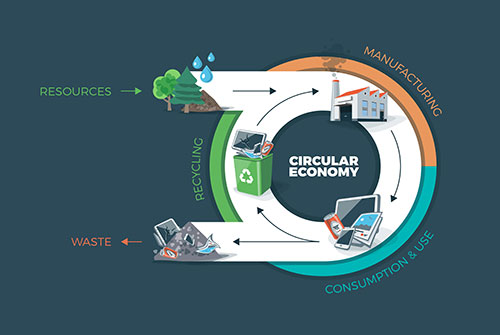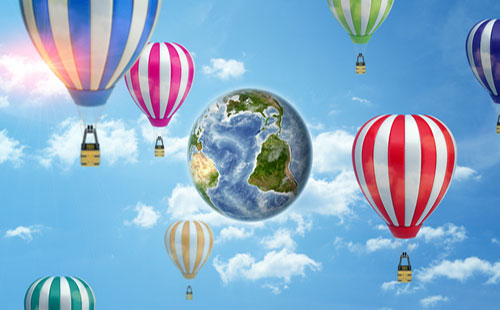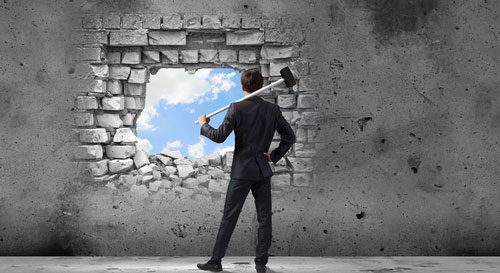Sustainable development requires disruptive changes in the way our societies and businesses are organized. The circular economy (CE) model offers a new chance of innovation and integration between natural ecosystems, businesses, our daily lives, and waste management. Find out below the definition, meaning, principles, advantages, and barriers to a circular economy model.
Definitions Of Circular Economy
Simple Definition Of Circular Economy
In the linear economy, raw natural resources are taken, transformed into products and get disposed of. On the opposite, a circular economy model aims to close the gap between the production and the natural ecosystems’ cycles – on which humans ultimately depend upon.
This means, on one hand, eliminating waste – composting biodegradable waste or, if it’s a transformed and non-biodegradable waste, reusing, remanufacturing and finally recycling it. On the other hand, it also means cutting off the use of chemical substances (a way to help regenerate natural systems) and betting on renewable energy.
- Related:
The World Economic Forum’s Definition Of Circular Economy
“A circular economy is an industrial system that is restorative or regenerative by intention and design. It replaces the end-of-life concept with restoration, shifts towards the use of renewable energy, eliminates the use of toxic chemicals, which impair reuse and return to the biosphere, and aims for the elimination of waste through the superior design of materials, products, systems, and business models. ”
Ellen McArthur Foundation’s Definition Of Circular Economy
“Looking beyond the current take-make-dispose extractive industrial model, a circular economy aims to redefine growth, focusing on positive society-wide benefits. It entails gradually decoupling economic activity from the consumption of finite resources and designing waste out of the system. Underpinned by a transition to renewable energy sources, the circular model builds economic, natural, and social capital. It is based on three principles: design out waste and pollution; keep products and materials in use; regenerate natural systems.”
The Principles Of A Circular Economy

The Principles Of The Circular Economy: Energy and Resources Are Gold
At its core, a circular economy model has the intention of designing out waste. In fact, a circular economy is based on the idea that there is no such thing as waste. In order to achieve this, products are designed to last (good quality materials are used) and optimized for a cycle of disassembly and reuse that will make it easier to handle and transform or renew them.
In the end, these tight product cycles differentiate the circular economy model apart from disposal and recycling, where large amounts of embedded energy and labor are lost. The ultimate goal is to preserve and enhance natural capital by controlling finite stocks and balancing renewable resources flows.
The Principles Of The Circular Economy: Following Nature’s Cycles And Designs
The circular economy model makes a distinction between technical and biological cycles. Consumption happens only in biological cycles, where biologically-based materials (such as food, linen or cork) are designed to feed back into the system through processes like anaerobic digestion and composting.
These cycles regenerate living systems, such as soil or the oceans, which provide renewable resources for the economy. By their turn, technical cycles recover and restore products (e.g. washing machines), components (e.g. motherboards), and materials (e.g. limestone) through strategies like reuse, repair, remanufacture or recycling.
Ultimately, one of the purposes of the circular economy is to optimize resource yields by circulating products, components, and the materials in use at the highest utility at all times in both technical and biological cycles.
The Principles Of The Circular Economy: All In With Renewable Energies
The last principle of a circular economy has to do with the fact that the energy required to fuel this cycle should be renewable by nature, with the purpose of decreasing resource dependence and increasing systems’ resilience. In this sense, this principle is about developing the systems’ effectiveness by revealing and designing out negative externalities.
Benefits Of The Circular Economy Model

Since the industrial revolution, humankind has been following a linear model of production and consumption. Raw materials have been transformed into goods that are afterward sold, used and turned into waste that has been many times unconsciously discarded and managed.
On the opposite, the circular economy is an industrial model that is regenerative by intention and design and aims to improve resources’ performance and fight the volatility that climate change might bring to businesses. It has benefits that are operational as well as strategic and brings together a huge potential for value creation within the economical, business, environmental and societal spheres.
Fewer Greenhouse Gas Emissions – Environmental Benefits Of The Circular Economy
One of the goals of the circular economy is to have a positive effect on the planet’s ecosystems and to fight the excessive exploitation of natural resources. The circular economy has the potential to reduce greenhouse gas emissions and the use of raw materials, optimize agricultural productivity and decrease the negative externalities brought by the linear model. When it comes to reducing greenhouse gases, a circular economy can be helpful:
- Because it uses renewable energy that in the long run is less polluting than fossil fuels.
- Thanks to reusing and dematerializing, fewer materials and production processes are needed to provide good and functional products.
- Because residues are seen as valuable and they are absorbed as much as possible in order to be reused in the process.
- Since the preferred choices will be energy-efficient and non-toxic materials and manufacturing and recycling processes will be selected.
As a matter of fact, an Ellen MacArthur Foundation study found out that a circular economy development path could halve carbon dioxide emissions by 2030, relative to 2018 levels.
Healthy And Resilient Soils – Environmental Benefits Of The Circular Economy
The principles of the circular economy on the farming system ensure that important nutrients are returned to the soil through anaerobic processes or composting, which softens the exploitation of land and natural ecosystems. In this way, as “waste” is returned to the soil, besides having fewer residues to deal with, the soil gets healthier and more resilient, allowing a greater balance in the ecosystems that surround it.
As well, since soil degradation costs an estimated US$40 billion annually worldwide, and has hidden costs such as the increase of fertilizer use, loss of biodiversity and loss of unique landscapes – a circular economy could prove to be really useful for both the soils and the economy.
In reality, a circular economy model working in Europe’s food systems has the potential to decrease 80% of the use of artificial fertilizer and therefore contributing to the natural balance of soils, according to a study from the Ellen MacArthur Foundation.
- More information on the negative impacts of the linear economy on the soil in our article > The ecological impact of coffee.
Fewer Negative Externalities – Environmental Benefits Of The Circular Economy
Following the circular economy’s principles, negative externalities such as land use, soil, water and air pollution are better managed, as well as the emission of toxic substances and climate change.
https://youmatter.world/en/definition/climate-change-meaning-definition-causes-and-consequences/
Increased Potential For Economic Growth – Economic Benefits Of The Circular Economy
It is important to decouple economic growth from resource consumption. The increase in revenues from new circular activities, together with a cheaper production by getting products and materials more functional and easily disassembled and reused, has the power to increase GDP and therefore economic growth, according to a McKinsey report.
More Resources Saved – Economic Benefits Of The Circular Economy
When compared with the raw material extraction that’s common on the linear approach, the circular economy model has the potential to lead to a bigger (up to 70%) amount of material savings. Considering that the total demand for materials will increase due the growth of the world population and middle classes, a circular economy leads to lower material needs, as it skips landfills and avoids recycling, focusing on making materials’ cycles last longer. On the environmental side, it also avoids bigger pollution that extracting new materials would represent.
Employment Growth – Economic Benefits Of The Circular Economy
According to the ‘world economic forum‘, the development of a circular economy model, together with a new regulation (including taxation) and organization of the labor markets, can bring greater local employment in entry-level and semi-skilled jobs.
As well, the ExTax tax report made by specialists from several top consultancy firms also concluded about the potential of the circular economy to create new job. The same conclusion was reached by an August 2018 study on the development of practices to implement a circular economy says that 50,000 new jobs could be generated in the UK and 54,000 in the Netherlands.
Another study conducted by the Ellen MacArthur Foundation and McKinsey also concluded on the changes in employment growth in case of a shift to a circular economy model. The study says that these new jobs will be created through increases in:
- Recycling and repairing practices, where one could add new designers and mechanical engineers to make lasting and easily disassembled products and materials at the transformation/production stages;
- An increase in new businesses (and niches) due to innovation processes and new business models;
- An increase in consumption and spending by lower prices.
New Profit Opportunities – Benefits Of The Circular Economy On Businesses
Lower input costs and in some cases create entirely new profit streams that can be achieved by businesses that move to the circular economy model. In this circular sphere, profit opportunities may come from playing in new markets, cutting costs off with waste and energy reductions and the assurance of continuity of supply.
China Has A New Policy That Will Ban Plastic Waste: Can It Turn Out To Be Something Good?
Volatility Reduction And Safeguarded Supplies – Benefits Of The Circular Economy On Businesses:
Moving towards a circular economy model means reducing the number of raw materials used. Instead, more recycled (or even reusable or easily transformed) inputs that have a higher share of labor costs would be used, leaving companies less dependent on the volatility of the price of raw materials. This would also protect companies from geopolitical crises and safeguard them regarding their supply chains – whose probably to be destroyed or damaged because of climate change events is increasing every day. In the end, the circular economy model would turn businesses more resilient, or in other words, make them more resistant and prepared to deal with unexpected changes.
The Demand For New Services – Benefits Of The Circular Economy On Businesses
According to Ellen McArthur’s Foundation report, a circular economy model has the potential to create demand for new services and new job opportunities such as:
- “Collection and reverse logistics companies that support end of life products being reintroduced into the system
- Product marketers and sales platforms that facilitate longer lives or higher utilization of products
- Parts and component remanufacturing and product refurbishment offering specialized knowledge “
These new services can be both identified by the top management decision-makers, or as well, in a well-developed green by employees from all levels and departments. To get to know more follow on our page > Green human resources management.
Getting To Know Clients Better – Benefits Of The Circular Economy on Businesses
The circular economy model seems to foster business models where products are rented or leased by customers during different periods of time, depending on the type of products. This gives businesses the chance to learn about their customer’s usage patterns and behaviors, as they get to interact more often with them.
Ultimately, this new relationship might just improve customer satisfaction and loyalty, and contribute as well for the development of products and services that suit clients better. In a market where suppliers remain responsible for the product supplied for a longer period, communicating well and understanding the clients’ preferences and needs is more important than ever.
- More information about this topic on our page > stakeholder engagement definition & strategies.
Barriers To The Implementation Of A Circular Economy Model

Implementing a circular economic model would have several benefits for the environment, economy and businesses, as we’ve discussed above. Nevertheless, there are some reasons that explain why this model has been growing slowly.
Economic Barriers To A Circular Economy Model
In our current economic system, there are some barriers to the implementation of a circular economy model, such as:
- Social and environmental externalities are not considered in prices, privileging financial market signals instead of people and nature when economic decisions are made;
- Prices of raw materials are fickle and at low prices alternative, good quality secondary resources are not competitive;
- Circular economy business models are harder to develop, as most investors are still working under a linear economy logic and sometimes upfront investments are required;
- The demand for circular products and alternatives is still small,
- There aren’t still many qualified professionals with technical or ‘information and communication technology’ (ICT) knowledge.
Institutional Barriers To A Circular Economy Model
When it comes to implementing and developing the circular economy, many different barriers might need to be overcome, such as:
- The fact that our current economic system is geared towards the demand of the linear economy and ain’t yet prepared to deal with circular economy entrepreneurs;
- New business models may be challenging to implement and develop because of laws and regulations that aren’t prepared for this kind of innovations;
- Plenty of businesses rely on old and/or strong alliances, making it harder to create new alliances and therefore to close loops;
- Many companies still have goals and appraisal systems that focus on short-term value creation, whereas the circular economy model is a long-term value creation model;
- The GDP index doesn’t consider social and environmental externalities, discouraging the creation of value in both these areas;
A Broad Perspective On The Barriers To A Circular Economy Model
A Swedish study conducted in 2017 that aimed to integrate different perspectives on this topic suggests that the main barriers to moving towards the circular economy model can be divided into financial, structural, operational, attitudinal and technological.
The first barrier has to do with the challenge of measuring the financial benefits of CE and its profitability. The ‘structural’ barrier that follows has to do with being unclear of gets responsible for CE within companies. By their turn, ‘operational’ challenges represent the difficulty of dealing and staying in control of processes within the value chain. The fourth barrier, ‘attitudinal’, has mostly demonstrated the lack of knowledge about sustainability issues and also a big risk aversion – it shows that disruptive changes aren’t the best way to develop circular strategies.
The last barrier to a circular has a technological origin and it has to do with the need for changing and re-designing products and production/ take-back systems. These needs end up creating concerns about the ability to do this and still being competitive and having quality products.
[box] Some of the sources used to find out more about the circular economy:
- European Commission
- World Economic Forum Report
- Science Direct Article 1
- Science Direct Article 2
- Ellen McArthur Foundation
- Ellen McArthur Foundation’s Report 2015
- Ellen McArthur Foundation’s Report 2016
- Fiscal Reforms for Circular Economy Report
- KENNISKAARTEN Knowledge Map
- McKinsey Report
- The Ex’Tax Project [/box]
Image credits for Shutterstock on: circular economy model definition, circular economy definition principles, circular economy model benefits, circular economy model economic benefits, circular economy barriers & circular economy sustainable development